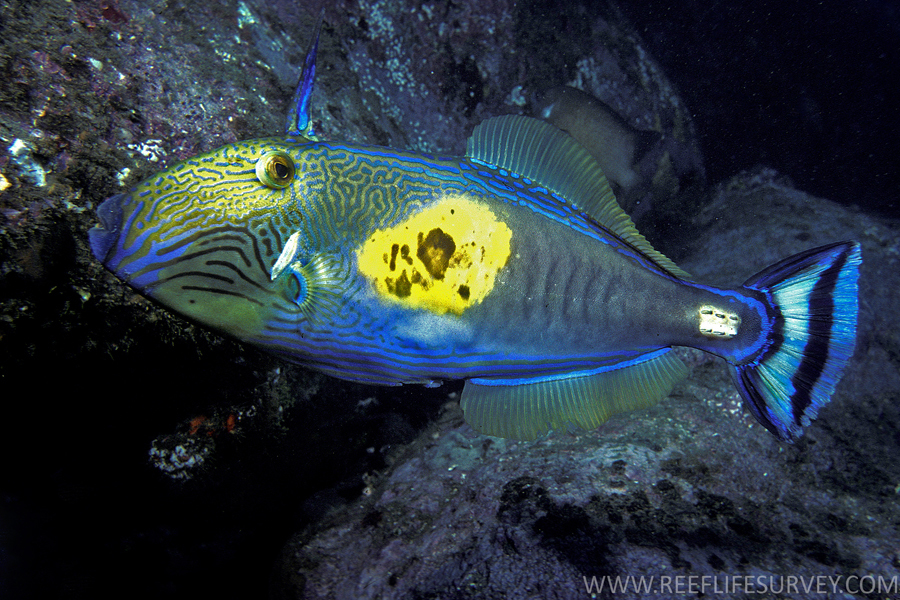Sixspine Leatherjacket, Meuschenia freycineti (Quoy & Gaimard 1824)

A male Sixspine Leatherjacket, Meuschenia freycineti. Source: Andrew J. Green / Reef Life Survey. License: CC BY Attribution
A common leatherjacket in southern Australia with a highly variable colour pattern. Adults have two to four pairs of curved spines on each side of the tail base, that are larger in males than in females and juveniles. Both males and females have a distinct dark crescent-shaped band near the hind margin of the tail.
Males are bluish with fine blue lines and spots on the head, blue lines along the dorsal and anal-fin bases, and often a large yellow to orange patch, or indistinct yellowy blotches on the sides.
Females and juveniles are pale greenish, yellow or brown, with blue lines and spots on the head and several broad dark stripes along the sides.
Sixspine Leatherjacket, Meuschenia freycineti (Quoy & Gaimard 1824)
More Info
|
Distribution |
Endemic to temperate waters of southern Australia, from south of Coffs Harbour, New South Wales, to Jurien Bay, Western Australia, and around Tasmania; also recorded from Lord Howe Island in the Tasman Sea. Found on shallow to deep reefs in bays, harbours and along the coast in depths to 145 m; juveniles are common in sheltered areas, especially seagrass beds. |
|
Features |
Dorsal fin II, 32-38; Anal fin 31-36; Caudal fin 12; Pectoral fin 11-14; Vertebrae 20 |
|
Size |
To 60 cm. |
|
Colour |
Males and females are sexually dimorphic and the colour pattern is highly variable throughout their range. Males usually bluish, with fine angled blue lines and spots on the head, distinct lines along the bases of the dorsal and anal fins, and often a large yellow or orange patch, or indistinct yellowy blotches on the sides. Females and juveniles usually pale greenish, yellow or brown, with blue lines and spots on the head and several broad dark stripes along the body. Both males and females have a distinct dark crescent-shaped band near the hind margin of the tail. |
|
Feeding |
Feeds on benthic invertebrates, including hydroids, molluscs, crustaceans and polychaetes, as well as consuming some epiphytic algae |
|
Similar Species |
The Yellowfin Leatherjacket, Meuschenia trachylepis, differs in having 2 pairs of spines on each side of the caudal peduncle, vs 3-4 pairs of spines in M. freycineti. In both species, the spines are prominent in males and smaller in females and juveniles. |
|
Author |
Bray, D.J. 2017 |
|
Resources |
|
Sixspine Leatherjacket, Meuschenia freycineti (Quoy & Gaimard 1824)
References
Bell, JD, JJ Burchmore & DA Pollard. 1978. Feeding Ecology of Three Sympatric Species of Leatherjackets (Pisces : Monacanthidae) from a Posidonia Seagrass Habitat in New South Wales. Australian Journal of Marine and Freshwater Research 29(5): 631-643.
Castelnau, F.L. de 1872. Contribution to the ichthyology of Australia. 1. The Melbourne fish market. Proceedings of the Zoological and Acclimatisation Society of Victoria 1: 29-242 1 pl.
Castelnau, F.L. de 1873. Contribution to the ichthyology of Australia. 3. Supplement to the fishes of Victoria. Proceedings of the Zoological and Acclimatisation Society of Victoria 2: 37-58.
Edgar, G.J. 1997. Australian Marine Life: the plants and animals of temperate waters. Reed Books. Pp. 544.
Grant, E.M. 1991. Fishes of Australia. Brisbane : EM Grant Pty Ltd 480 pp.
Hutchins, J.B. 1977. Descriptions of three new genera and eight new species of monacanthid fishes from Australia. Records of the Western Australian Museum 5(1): 3-58 figs 1-13
Hutchins, J.B. 1994. Family Monacanthidae. pp. 866-891 figs 767-787 in Gomon, M.F., Glover, C.J.M. & Kuiter, R.H (eds). The Fishes of Australia's South Coast. Adelaide : State Printer 992 pp. 810 figs.
Hutchins, J.B. 2008. Family Monacanthidae. pp. 822-841 in Gomon. M.F., Bray, D.J. & Kuiter, R.H (eds). Fishes of Australia's Southern Coast. Sydney : Reed New Holland 928 pp.
Hutchins, B. & R. Swainston. 1986. Sea Fishes of Southern Australia. Complete Field Guide for Anglers and Divers. Swainston Publishing. Pp. 180.
Kuiter, R.H. 1993. Coastal Fishes of South-eastern Australia. Bathurst : Crawford House Press 437 pp.
Kuiter, R.H. 1996. Guide to sea fishes of Australia. A comprehensive reference for divers and fishermen. Sydney, NSW, Australia : New Holland Publishers xvii, 434 pp.
Last, P.R., Scott, E.O.G. & Talbot, F.H. 1983. Fishes of Tasmania. Hobart : Tasmanian Fisheries Development Authority 563 pp. figs.
Quoy, J.R.C. & Gaimard, J.P. 1824. Chapter 8. Poissons. 183-328 pls 43-65 in Freycinet, L.C.D. de (ed.). Voyage autour du Monde, entrepris par ordre du Roi, exécuté sur les corvettes de S.M. Uranie et la Physicienne, pendant les années 1817, 1818, 1819 et 1820. Paris : Pillet Aîné Vol. 1 712 pp. 96 pls.













